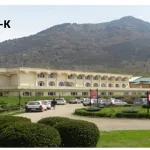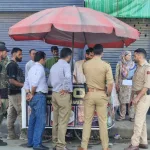SAFEGUARDING LIVES
In an era where global pandemics and foodborne illnesses dominate headlines, the importance of food safety has never been more critical. The confiscation of over 12,000 kilograms of rotten and unlabelled meat in J&K reveals a nefarious network that thrives on exploiting weak oversight. This scandal has laid bare the dangerous nexus between unscrupulous butchers, meat Mafia, and lax regulatory oversight.
This “meat mafia” sources substandard meat — classified as B-grade, often from diseased animals or already contaminated—from Ghazipur Mandi where rejected mutton, chicken, and beef are collected alongside entrails, trims, and suet from processing units. These products, unfit even for animal consumption, are treated with chemicals like chlorine, ammonium hydroxide, and nitrate acids to mask odors and create a deceptive “fresh” appearance.
Transported in ordinary trucks without cold chain facilities and during this process meat thaws in transit, fostering microbial growth before being frozen again in makeshift facilities like ice-cream factories or supplied directly to Food Business Operators (FBOs). Such practices not only violate Food Safety and Standards Authority of India (FSSAI) and is a direct violation of public trust and a direct threat to human health, potentially paving the way for disease outbreaks.
In J&K, where meat demand is high and oversight often lax, this creates a booming market for unscrupulous traders. Meanwhile Poultry shops further exacerbate the issue, with half their stock comprising sick or discarded birds, stealthily substituted for healthy ones or pre-cut to deceive consumers. These practices, coupled with the absence of robust checks further betray the public trust.
The importance of food safety in today’s world cannot be overstated. With global populations growing and food supply chains becoming increasingly complex, ensuring the safety of what we consume is critical to public health. Contaminated meat can harbor deadly pathogens from bacteria, viruses to parasites and many of which are having zoonotic potential that is capable of transferring from animals to humans.
The Indispensable Role of Veterinary Oversight
At the heart of ensuring meat safety lies the critical role of veterinarians. Trained to detect diseases, infections, and abnormalities in livestock, veterinarians are the first line of defense in the food supply chain. Through ante-mortem inspections, they assess the health of animals before slaughter, ensuring that only healthy ones enter the food system.Post-mortem inspections further verify that the meat is free from contaminants, such as abscesses, tumors, or signs of infectious diseases like anthrax, tuberculosis, brucellosis, or foot and mouth disease.
Without veterinary supervision, the risks are staggering. Unscrupulous butchers may slaughter sick, injured, or even dog-bitten animals, introducing dangerous pathogens into the food chain. Consuming such meat can lead to severe illnesses, from acute food poisoning to chronic conditions that burden healthcare systems and endanger lives. Mandating veterinary oversight at every stage of the slaughtering process is non-negotiable. It is a cornerstone of food safety that protects consumers and prevents public health disasters.
The Urgent Need for Modern Slaughterhouses
To bolster food safety, governments must prioritize the establishment of modern, hygienic slaughterhouses in every district and tehsil. These facilities should be equipped with state-of-the-art infrastructure, including proper waste disposal systems, cold storage units, and dedicated inspection stations staffed by qualified veterinarians. Such slaughterhouses would ensure that animals are processed in sanitary conditions, minimizing the risk of contamination. Regular veterinary inspections both ante-mortem and post-mortem would further guarantee that only safe, high-quality meat reaches consumers.
In contrast, unregulated or outdated slaughter facilities, often operating in unhygienic conditions, are breeding grounds for contamination. The absence of proper oversight allows diseased meat to slip through the cracks, as evidenced by the recent seizures of spoiled products. By investing in modern slaughterhouses, authorities can address these systemic failures, reduce the risk of foodborne illnesses, and restore public confidence in the meat supply chain.
Preventing the Next Zoonotic Crisis
The stakes are higher than ever. Over 60% of known infectious diseases in humans are zoonotic, originating from animals. Poor livestock management, inadequate slaughter practices, and lax meat inspections create a perfect storm for the spread of diseases. In 2025, with global travel and trade more interconnected than ever, a single lapse in food safety could trigger a global health crisis.
Veterinary oversight and modern slaughterhouses are critical tools in preventing such catastrophes. By ensuring that only healthy animals are slaughtered and that meat is processed under stringent hygienic conditions, these measures act as a firewall against zoonotic disease transmission. Governments must act swiftly to implement these safeguards, recognizing that food safety is not just a domestic issue but a global priority.
Consumers also have a role to play in demanding safer food. By purchasing meat only from certified vendors who adhere to strict safety protocols, consumers can drive demand for transparency and accountability in the food industry. Public awareness campaigns can educate people about the risks of buying from unregulated sources and the importance of veterinary-inspected meat.
On the regulatory front, authorities must adopt a zero-tolerance approach to food safety violations. Those caught distributing contaminated or unsafe meat—whether butchers, traders, or hoteliers—should face severe penalties, including hefty fines, license revocations, and criminal charges.
Regular inspections of slaughterhouses, meat markets, and food establishments are essential to deter malpractices and ensure compliance with safety standards. Technology, such as block chain-based traceability systems, can further enhance transparency, allowing consumers to verify the origin and safety of their meat. Let this scandal be the catalyst for change — a chance to rebuild trust, strengthen regulations, and ensure that every bite we take is safe, wholesome, and free from harm.
(Author is a Veterinarian)








